New Discoveries
 Welcome to the New Discoveries blog! City of San Diego City Clerk Archives staff use this area to upload newly rediscovered documents from San Diego’s history. In their duties, staff often find unique and interesting pieces of history they want to bring to the public. Those documents are uploaded here and then organized into their appropriate Collection, or a new Collection is created. Please check back frequently for fascinating new finds and discoveries!
Welcome to the New Discoveries blog! City of San Diego City Clerk Archives staff use this area to upload newly rediscovered documents from San Diego’s history. In their duties, staff often find unique and interesting pieces of history they want to bring to the public. Those documents are uploaded here and then organized into their appropriate Collection, or a new Collection is created. Please check back frequently for fascinating new finds and discoveries!
Published on
1969 - A League of her Own
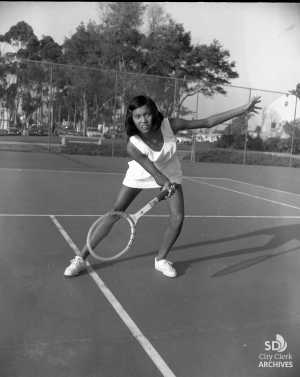
Download Image
Marita Redondo was born in 1956 in San Diego and played professional tennis from 1970 to 1982. With her signature devastating forehand and powerful game, she won the Atlantic City Tennis Classic Doubles in 1973, the Bridgestone Doubles Championships in 1976 and the Sillook Championships in Japan in 1976, 1978 and 1979. Her highest US ranking was five in 1976 and her career-best world ranking was nine. Marita has remained active in the San Diego Tennis Community. She was inducted into the San Diego Tennis Hall of Fame in 2012.
Published on
September 26, 1972 - “We Are Family” The Sister City Program
The Sister City Program was created at President Eisenhower’s 1956 White House conference on citizen diplomacy. Eisenhower envisioned an organization that could be the hub of peace and prosperity by creating bonds between people from different cities around the world. By forming these relationships, President Eisenhower reasoned that people of different cultures could celebrate and appreciate their differences and build partnerships. The City of San Diego established its first City relationship with Yokohama, Japan, on March 11, 1958. The City Council established a uniform policy as guidelines for the maintenance and expansion of San Diego’s Sister City Program in 2000. Since the date, at the recommendation and in accord with the International Affairs Board, San Diego has 18 additional Sister Cities.
Published on
April 16, 1975 - Dr. John R. Ford Day
Dr. John R. Ford (1923-2009), a highly esteemed surgeon and first African American president of the State Board of Education. Ford was appointed by Gov. Ronald Reagan to the California State Board of Education in 1968, he became its president in 1975. Dr. Ford came to San Diego and began his medical practice in 1954. He dedicated himself to enhancing health prospects for the African American community. Dr. Ford was the first recipient of the Southern California First National Bank. The City of San Diego officially proclaimed April 16, 1975, as "Dr. John R. Ford Day" to honor his substantial achievements.
Published on
1961 - Riding in Style
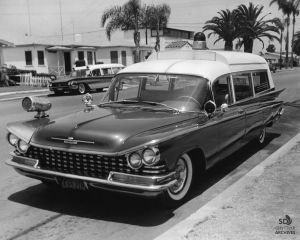
Download Image
Here is a photo of a Buick Ambulance parked on 30th Street in 1961. Prior to 1970, the San Diego Police Department performed basic emergency medical transportation in converted station wagons equipped with minimal medical supplies. The service was little more than loading the patient and driving as fast as possible to the hospital for medical attention. In 1997, the Fire-Rescue Department collaborated with Rural/Metro of San Diego to form the nation's first public-private partnership to provide 9-1-1 service.
Published on
June 20, 1917- First Policewoman
Lucile Jeardeau was the San Diego Police Department’s first policewoman, and she also was the first policewoman of Southern California. From this resolution we can know City Council appointed Miss Lucile Jeardeau as a special policewoman for a term of three months, with a monthly salary of $75.00. She patrolled the streets and beaches enforcing the bathing suit regulations of the time. Lucile Jeardeau was born in Wisconsin 1869, and she came with her family to the La Jolla area in 1895.
Published on
April 5, 1900 - “New Set of Wheels”
Look at this cool documentation submitted by the Board of Police Commissioners requesting for a new bike to patrol the streets of San Diego. A resolution adopted on April 5th, 1900 by the City Council, at that time called the Common Council.
Published on
1900 - Pioneer Truck Company
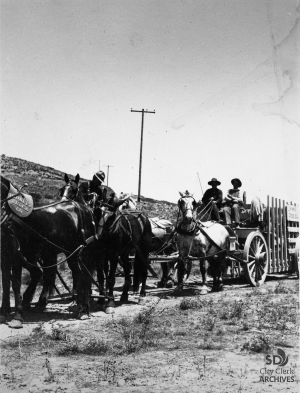
Download Image
The historical picture, captured in 1900, showcases a horse-drawn moving truck utilized by the Pioneer Truck Company. The company was established by Hiram Gould and later carried on by Elwyn Bremer Gould in 1899. The initial location of the company was at 1427 E Street and by 1906, it was listed at 1314 E Street. Collaboratively, Roscoe E. Hazard and Elwyn Blaine Gould (Hiram's grandson) established the Pioneer Transfer & Storage Company of San Diego. In 1928, the company merged with several others to form Lyon Van & Storage Company, with Elwyn Blaine Gould as its first president.
Published on
March 31, 1933 - “New Deal” Program
Based on historical document dated back to 1933, the city prepared to use five acres of city-controlled lands in the Pauma Valley near the intersection of Santa Ysabel Creeks for the establishment of the camp for the President’s Emergency Conservation Work Program. On March 31, 1933, President Franklin D. Roosevelt signed into law an act creating the Emergency Conservation Work Program, better known as the Civilian Conservation Corps (CCC). This program became one of the most popular and successful of Roosevelt's "New Deal" programs designed to bring pre-war America out of the Great Depression. Between 1933 and 1942, when the CCC program ended, a total of 2 million enrollees had worked in 192 camps in 94 National Park Service areas as well as 697 camps in 881 state, county, and municipal areas.
Published on
1887 – Circus Parade in Downtown
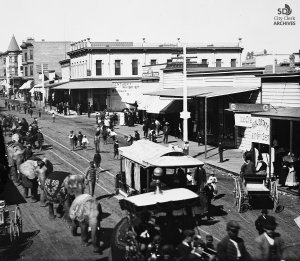
Download Image
You have to see this amazing picture of a circus visiting San Diego in 1887! Elephants and camels were on the scene, and it definitely made everyone stop in their tracks. Imagine having these exotic animals strolling around your city! In our City Clerk’s Archive, there are records of Ringling Bros, Wallace Shows and other circuses performing in the city during this time. These travelling circuses would traverse various towns, accompanied by an entourage of animals.
Published on
January 31, 1877 - Board of Health Requested a Hospital for Smallpox Patients
In the 1877, the Board of Health requested the Board of Trustee to provide suitable hospital deemed to assist smallpox patients regarding the smallpox outbreak in San Diego. A historical petition was approved in the Book of Resolutions SEC 3022. Throughout the 19th century, the San Diego region experienced several smallpox epidemics.
Published on
Undated – Early Bus Full of Passengers
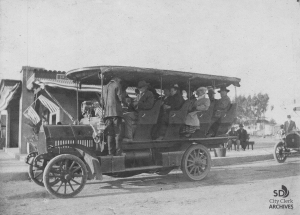
Download Image
Today, San Diego’s transportation system is highly developed and incredibly convenient, whether you prefer driving or choosing public transportation like buses, trolleys, or the Light Rail. But going back one century ago, personal automobiles were rare, and most people relied on the services of various auto stages to travel. This early bus in the picture was owned by the local auto stage in La Mesa, connected to the streetcar from San Diego. Each ride carried 15 passengers and ran five trips per day.
Published on
February 26, 1994 - Edith Lyle Anderson Day
See this resolution regarding San Diego’s First Black Female bank employee. Edith Lyle Anderson was born on February 23, 1919, in Vicksburg, Mississippi. She moved to San Diego on April 1, 1944. She was an active member on the Fourth District Seniors Commission. Edith retired after a remarkable 40-year banking career that began with U.S. National Bank. A devoted member of the Jackie Robinson YMCA, her love of life was traveling the world.
Published on
1890 - San Diego’s First Development of the Jewish Community
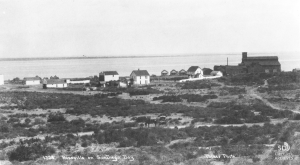
Download Image
Take a look at this incredible photo from 1890 showcasing Roseville on the Point Loma Peninsula. It's connected to a well-known San Diego pioneer named Louis Rose. Louis Rose was a German Jewish immigrant and San Diego’s first identifiable Jewish resident. Rose was a pioneer developer of San Diego, California. He came to San Diego in 1850, via New Orleans, Louisiana, and Texas. Arriving just as California became a state in 1850, he was San Diego’s first member of the County Board of Supervisors. Another interesting fact is that the neighborhood of Roseville in Point Loma, Rose Creek and Rose Canyon are named after him. Rose was a founding member of Congregation Beth Israel. Congregation Beth Israel became Temple Beth Israel, San Diego’s largest synagogue.
Published on
October 13, 1915 – Cost of Horse Care
This 1915 Resolution No. 20495 accepted the bid of Dr. O. A. Diller to care for 8 horses belonging to the Police Department. The monthly fee per horse is $18, making $144 per month, and $1,728 per year. Since 1889, horses served as the primary means for police patrols in remote areas. However, in 1916, they were replaced by automobiles. With the reinstitution of patrols in Balboa Park, mounts were once again used in 1932. This modern mounted patrol was disbanded in 1948. It was revived in 1983 and ceased in 2010.
Published on
1963 – San Diego Zoo
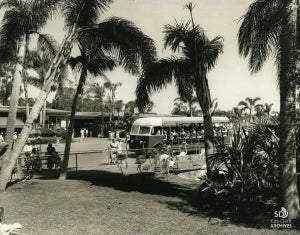
Download Image
Please take a moment to view this interesting photo capturing flamingos in a serene pose amidst a bustling tour bus and a gathering of onlookers. San Diego Zoo has established itself as a prominent landmark in our city and an essential destination for visitors. Established in 1916, San Diego Zoo has grown into one of the world's largest zoos, housing over 14,000 rare and endangered animals. By providing a space for families to share enjoyable moments together, the Zoo also serves as a valuable educational resource, reminding us of our duty to protect and preserve wildlife.
Published on
April 6, 1908 - Petition of W. L. Short to Sell Pennants During the Visit of American Fleet to San Diego
W. L. Short submitted the petition in 1908 to sell Pennants during the visit of American fleet, with the purpose of providing more employment opportunities. In April 1908, the 16 battleships of the "Great White Fleet" anchored near the Coronado for four days. During this time, thousands of sailors and marines took part in a splendid parade through the streets of San Diego. It is worth mentioning that this historic event was part of President Theodore Roosevelt's strategic effort to demonstrate the immense maritime power of the United States by sending the U.S. battleship fleet on global expeditions from 1907 to 1909.
Published on
1923 – Image from the movie “Red Lights”
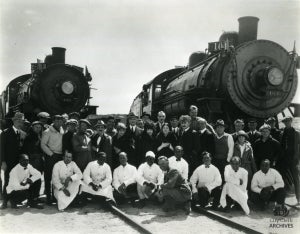
Download Image
This particular image showcases the cast alongside select members of the crew from the Goldwyn Pictures film titled, “Red Lights” (1923). Notably, the backdrop includes the prominent presence of locomotives #104 and #105 from the San Diego and Arizona Railroad. This film was a captivating silent mystery, directed by Clarence G. Badger, starring Marie Prevost, Raymond Griffith, and Johnnie Walker. Much of the movie takes place on a moving train with red lights flashing throughout many of the scenes, can you imagine the suspense and excitement?
Published on
July 5, 1934 – Morley Field
In this historical document from 1934, John G. Morley's significant contributions to the development of the San Diego Park System are recognized. As a tribute to his efforts, the Recreation Area in the northeast corner of Balboa Park was named "Morley Field." Morley began serving as superintendent of San Diego’s parks in 1911. During his 27 years in office, our beloved park flourished and transformed into the breathtaking beauty we see today under his wise guidance and unwavering inspiration. Morley assumed office just in time for the preparations of the extraordinary 1915 Panama-California Exposition, during which the Park Commission required a proficient administrator to showcase Balboa Park and oversee other city park projects. Leveraging his expertise in landscaping, Morley deftly resolved challenges associated with park landscape construction. Furthermore, he skillfully utilized his diplomatic communication skills to establish productive collaboration with engineers and architects involved in the Exposition, ensuring efficient progress of the work.
Published on
June 23, 1925 – Giant Dipper Roller Coaster and Its Builders
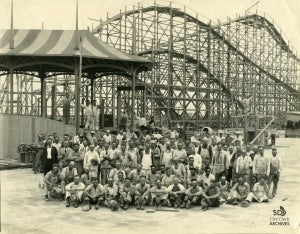
Download Image
It is amazing to see a group of hardworking construction workers striking a pose in front of the soon-to-be-completed Giant Dipper roller coaster. Can you believe that it's because of their dedication and effort that the Mission Beach Amusement Center (now known as Belmont Park) opened its doors on July 4, 1925? Talk about historical significance! This amusement park was developed by the sugar magnate, John D. Spreckels. The locals in San Diego have countless happy and unforgettable memories of this iconic spot. It holds a special place in our hearts.
Published on
January 14, 1895 – Russ High School to State Normal School
According to this historical document from 1895, Mayor William H. Carlson convened a mass meeting to discuss offering the Russ School house and grounds to the State Normal School. This proposal was prompted by the growing population of the city and the scarcity of teachers, making the establishment of normal schools a pressing necessity during that era. It's worth noting that the Russ Public School, which was founded in 1882 and named after lumberman Joseph Russ, eventually evolved into the present-day San Diego High School. Subsequently, the San Diego Normal School was established on March 13, 1897, and is now known as San Diego State University, situated in University Heights.

